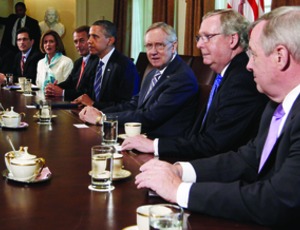As an Aug. 2 deadline looms on raising the federal debt limit and with no deal yet in sight (at ENR's press time), anxious construction industry officials await Washington's next move as lawmakers negotiate a plan to steer the U.S. clear of a default on its debt obligations.

Construction economists say if congressional leaders and the White House fail to strike a deal on hiking the $14.3-trillion debt ceiling, the consequences for the industry would be dire. They say interest rates would likely jump across the board and credit would be pinched much tighter than in 2008, slamming the brakes on new projects.
But if a debt agreement is reached, and it is accompanied by cuts in federal spending, that too would be bad news for construction because the cuts almost certainly would hit infrastructure programs and hurt design, construction, materials and equipment companies that rely on federal work.
A no-deal scenario would hit the economy broadside and batter construction. Robert Murray, McGraw-Hill Construction vice president for economic affairs, says, “It would be a negative impact that would cover the spectrum of the industry. The recovery for construction, which seemed to be gaining some momentum about a year ago, has stalled. So if you have a failure to raise the debt limit, it more or less ensures that construction is going to not just remain stalled, but to fall back once again.” (ENR is a unit of McGraw-Hill Construction.)
Murray says interest rates would rise, putting off any rebound in single-family housing construction, deferring recovery in the commercial-building sector and making declines in institutional construction and public works “even steeper.”
Anirban Basu, Associated Builders and Contractors chief economist, says, “The construction industry stands to lose more than any other industry if a debt-ceiling agreement is not reached by August 2nd.” He adds, “The most likely impact of failing to reach resolution would be spiking interest rates, and the effect of default would be long-lived.”
Ken Simonson, the Associated General Contractors chief economist, says the results of failing to lift the debt limit “are potentially far-ranging, disastrous and unforeseeable” for construction. He says interest rates could “shoot up, not just for Treasury bonds but for everything tied to them—and basically for every borrower in the U.S.” Simonson adds that “credit availability would shrink drastically, far more than in the fall of 2008 when private projects were stopped in midstream.”
Ed Sullivan, Portland Cement Association chief economist, says the impact of default would be severe and would likely include spending cuts in government construction programs. Sullivan says cement consumption would likely fall 5.6% in 2011 and drop 7.5% in 2012.
President Obama has called for a debt-limit boost through next year and $4 trillion in deficit reduction over 10 years. “I am still pushing for us to achieve a big deal,” he said on July 15. But if that isn't possible, he said, “let's still try to at least get a down payment on deficit reduction.”
Obama warned on July 19, “The problem we have now is we're in the 11th hour and we don't have a lot more time left.” But he welcomed a July 19 bipartisan proposal from the Senate “Gang of Six” to cut the deficit by $3.7 trillion over 10 years, including $500 billion up front.


Post a comment to this article
Report Abusive Comment